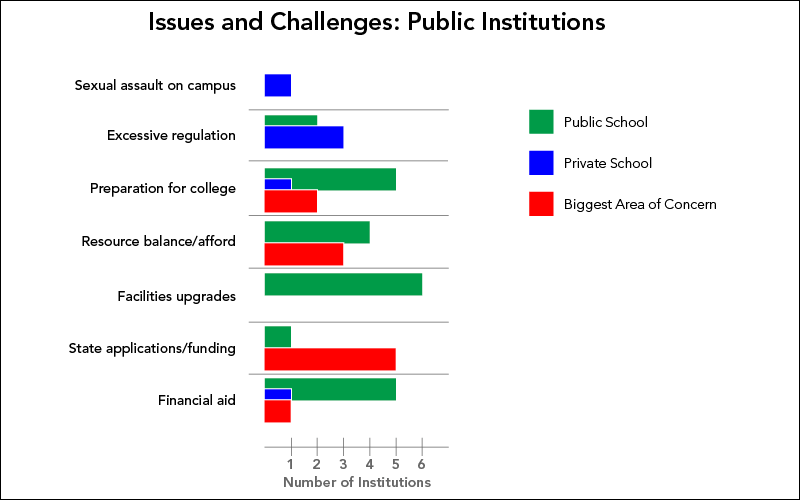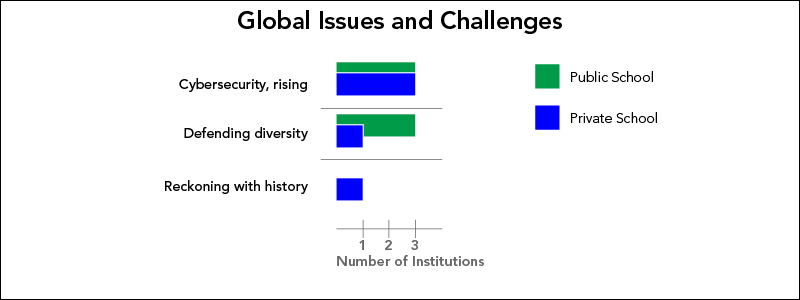We had an excellent day of collaboration and learning at our third annual Higher Education: Current Issues and Trends event held at Northern Kentucky University on March 23, 2017. During the event, we had the pleasure of hosting Dr. Kenneth L. Hoyt, Ph.D. of The Higher Education Practice, LLC, who shared a wealth of knowledge and ideas with our attendees.
Dr. Hoyt’s presentation, “Higher Education Issues and Challenges with Practical Solutions,” focused on identifying the top issues that face public and private institutions in our region. Attendees were asked to come to the front of the room and identify the issues and challenges they consider most significant in the current higher education landscape, regardless of whether they were from a private or public institution. Through this exercise it was quickly noticeable that private and public institutions face many of the same issues and challenges.

Public issues and challenges that were listed in the activity but not selected by attendees included student loan crisis, free speech, and campus police.


Global issues and challenges that were listed in the activity but not selected by attendees included information literacy, activist athletes, safety net, sanctuary campus, cultural divide, Titles IX due process, and harassment vigilance.
During the session, Dr. Hoyt handed out four green dots to attendees from public institutions, four blue dots to attendees from private institutions, and one red dot to all attendees. He instructed everyone to come to the front of the room where he had several charts — all labeled as issues and challenges for public or private institutions (as perceived in the marketplace) and one with the global list recently published by The Chronicle of Higher Education. Attendees were asked to place their dots wherever they felt most inclined, regardless of whether they were from a public or private institution. The results are displayed in the three charts below — the red indicating biggest area of concern. These results led to further discussion of the biggest issues and challenges identified.
Among the most significant issues that were discussed were:
- Student retention and enrollment management: This was identified as a key factor of success for all institutions. The attendees nearly unanimously agreed that this was one of the biggest issues facing public and private institutions. Attracting the right students and keeping them engaged for the entire life of a program of study is one of the best ways to secure an adequate revenue stream.
- Access versus tuition discounting and the cost of education: Controlling the price of tuition was a significant hurdle discussed for all institutions. However, private institutions ranked this particularly high. All institutions strike a delicate balance between discounting tuition enough to ensure access for students that may not otherwise be able to attend, while at the same time having adequate revenue to cover the costs of education.
- Endowment management and resource allocation: For private institutions, fighting the pressures of keeping tuition affordable, proper management of investments within the endowment, and use of funds become more important.
- Speed of making decisions: Participating universities mostly agreed that the speed of making decisions was a hurdle for their organizations as they attempt to react to the swiftly changing environment of higher education.
- Facilities upgrades: It seems that the war is on to compete for students by upgrading facilities to be state of the art. Schools are getting creative to find ways to fund new facilities and those that can’t are finding it harder to attract students.
The event attendees also discussed ideas to help institutions figure out how to be more successful. They explored the concept of ensuring that the strongest programs with the best retention and least cost were given more focus than any programs with lower retention and higher cost. Focusing organizational resources on the lower-cost, more successful programs is a great way to increase retention and help ease the challenge of enrollment management.
Dr. Hoyt has helped a large number of institutions identify which programs are working and which are using more resources than they might be worth. Key indicators include the number of program inquiries, percentage of applications, graduation rate of the program, cost per student, and geographic demand measure, among many other items.
Ultimately, the income of an institution is greatly benefitted by improving graduation and retention rates and focusing on programs central to the mission of the institution that also provide the best student engagement. For more information, visit higheredpractice.com. We also recommend reading Dr. Hoyt’s article entitled “Reshaping Your Curriculum to Grow the Bottom Line. Optimizing Academic Balance (OAB): Mission, Quality, Market Potential, Cost and Revenue” in the January-March 2015 Planning for Higher Education Journal.







